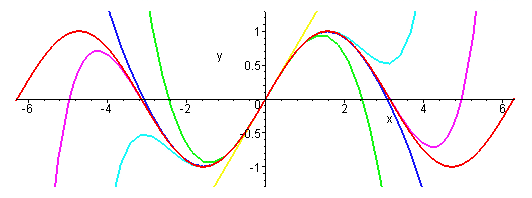In Appendix D of the 5th edition of
Intermediate Physics for Medicine and Biology,
Russ Hobbie and I review
Taylor’s Series. Our Figures D.3 and D.4 show better and better approximations to the
exponential function, e
x, found by using more and more terms of its Taylor’s series. As we add terms, the approximation improves for small |
x| and diverges more slowly for large |
x|. Taking additional terms from the Taylor’s series approximates the exponential by higher and higher order
polynomials. This is all interesting and useful, but the exponential looks similar to a polynomial, at least for positive
x, so it is not too surprising that polynomials do a decent job approximating the exponential.
A more challenging function to fit with a Taylor’s Series would look nothing like a polynomial, which always grows to plus or minus infinity at large |
x|. I wonder how the Taylor’s Series does approximating a bounded function; perhaps a function that oscillates back and forth a lot? The natural choice is the
sine function.
The Taylor’s Series of sin(
x) is
sin(x) = x – x3/6 + x5/120 – x7/5040 + x9/362880 - …
The figure below shows the sine function and its various polynomial approximations.
The red curve is the sine function itself. The simplest approximation is simply sin(
x) =
x, which gives the yellow straight line. It looks good for |
x| less than one, but quickly diverges from sine at large |
x|. The green curve is sin(
x) =
x –
x3/6. It rises to a maximum and then falls, much like sin(
x), but heads off to plus or minus infinity relatively quickly. The cyan curve is sin(
x) = x –
x3/6 +
x5/120. It captures the first peak of the oscillation well, but then fails. The royal blue curve is sin(
x) =
x –
x3/6 +
x5/120 –
x7/5040. It is an excellent approximation of sin(
x) out to
x = π. The violet curve is sin(
x) =
x –
x3/6 +
x5/120 –
x7/5040 +
x9/362880. It begins to capture the second oscillation, but then diverges. You can see the Taylor’s Series is working hard to represent the sine function, but it is not easy.
Appendix D in
IPMB gives a table of values of the exponential and its different Taylor’s Series approximations. Below I create a similar table for the sine. Because the sine and all its series approximations are odd functions, I only consider positive values of
x.
 |
| A table of values for sin(x) and its various polynomial approximations. |
One final thought. Russ and I title Appendix D as “Taylor’s Series” with an apostrophe s. Should we write “Taylor Series” instead, without the apostrophe s? Wikipedia just calls it the “Taylor Series.” I’ve seen it both ways, and I don’t know which is correct. Any opinions?





I vote for "Taylor Series." In Bill Bialek's recent biophysics book there's a nice footnote on Reynolds number, Bessel functions, and other apostrophe-less things: https://books.google.com/books?id=5In_FKA2rmUC&lpg=PA154&dq=bialek%20reynolds%20number&pg=PA154#v=onepage&q&f=false
ReplyDelete